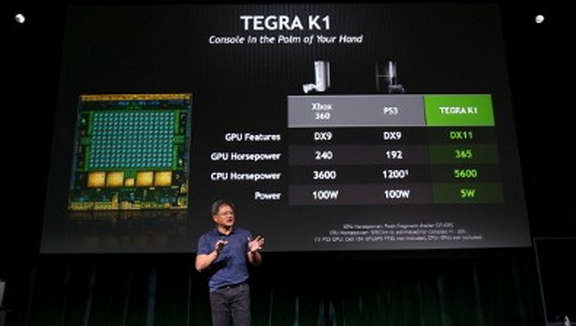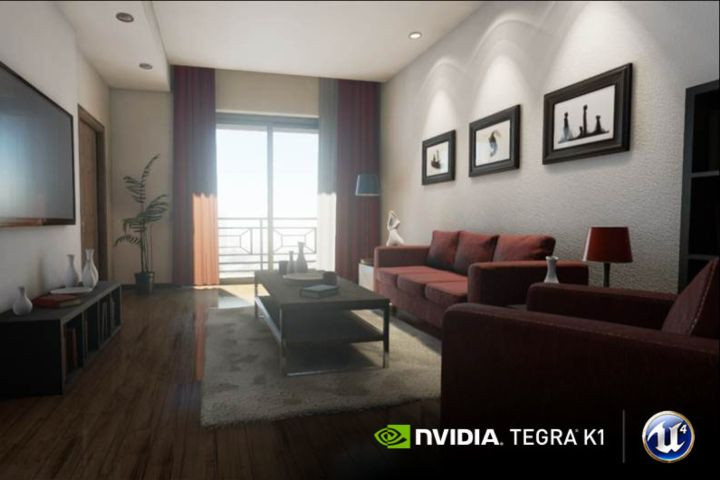Nvidia Unveils Mobile Chip ‘Faster’ Than PS3: 5 Fast Facts About The Tegra K1
Nvidia announced the predecessor to Project Parker at CES 2014

Nvidia (NASDAQ:NVDA) has unveiled the Tegra K1 in Las Vegas at the 2014 International CES. At a press event, Nvidia CEO Jen-Hsun Huang made bold claims for the Tegra K1, and said that the new system-on-a-chip (SOC) would see a release this year.
Nvidia decided against following the naming scheme that led up to 2013’s Tegra 4. This was because, Huang says, the company decided it would be “almost inappropriate to call it Tegra 5,” since the K1 was so much more powerful than its predecessor.
The Tegra K1 is a system-on-a-chip (SOC) combining a ARM-architecture CPU and up to a 192-core GPU. It is due for release in 2014, and here are five fast facts about Nvidia’s new chip:
1) Nvidia claims it is more powerful than the Xbox 360 and PS3
Previously codenamed Logan, Nvidia claims the Tegra K1 will offer significantly higher performance than the PlayStation 3 (PS3) and Xbox 360. If Nvidia’s metrics are to be believed, the Tegra K1 will offer more than half the speed of Microsoft and Sony’s last-gen consoles while only consuming about 5 percent of the power as those full-size boxes.

2) The Tegra K1 is Nvidia's first 64-bit chip
In an attempt to be first in the race to have the first 64-bit CPU for Android, a version of the Tegra K1 set for release in the second half of 2014 will feature a dual-core processor featuring the company's Denver technology. Nvidia has been drumming up interest in Denver since 2012, claiming the tech will offer next-gen performance while remaining battery-friendly.
The Tegra 4 had a 72-core GeForce GPU. The Tegra K1 boosts this to 192 cores, using the same Kepler architecture used in Nvidia’s current-gen graphics cards for desktops. The company will offer 32-bit and 64-bit versions of the chip, with the former appearing sometime in the first half of the year.
3) Games running Epic Games' Unreal Engine 4 will work on the Tegra K1
Nvidia has partnered with Epic Games to ensure that games developed using the company's next-gen Unreal Engine 4 will be fully compatible, and easily portable to devices run by the Tegra K1. Unreal Engine 3 was used to develop "Batman: Arkham City" and the "Gears of War" series, so the fourth iteration should see several graphics-intensive, next-gen titles which have not even been announced yet.
Nvidia is using the partnership to illustrate its claim, that the Tegra K1 will offer desktop performance in a mobile chip. The Tegra K1 also “fully supports DirectX 11, OpenGL 4.4, and tessellation.”
4) Nvidia needs the Tegra K1 to succeed
Nvidia is trying to drum up interest in the Tegra K1 by calling out the PS3 and Xbox 360 to hype the chip, while its predecessor was not a great success. A company formerly known for its graphics chips inside of desktop PCs, and later laptops, Nvidia has struggled to gain traction in a market dictated by the sale of smaller devices.
While the Tegra 4 had some success in car infotainment systems and on the Microsoft Note 2 tablet, it was not featured in a single flagship smartphone to hit stateside. The 2012 Nexus 7 featured that year's Tegra 3, Nvidia was replaced by Qualcomm (NASDAQ:QCOM) in the 2013 version of the Google tablet.
5) Project Parker, the code-name for the 6th Tegra chip, could blow the Tegra K1 out of the water
As with all things tech, next year’s model will be significantly more powerful. Huang has claimed that the Parker, code-name for 2015’s Tegra chip, will be roughly 100 times more powerful than 2011’s Tegra 2. While this year's Tegra K1 is about halfway there. Both Microsoft and Sony might have plenty to fear from Tegra Project Parker, since 2015 could see the release of a Nvidia mobile SoC that’s nearly as powerful as the two next-gen consoles.
Follow Thomas Halleck on Twitter @tommylikey and Google Plus +ThomasHalleck
© Copyright IBTimes 2024. All rights reserved.







